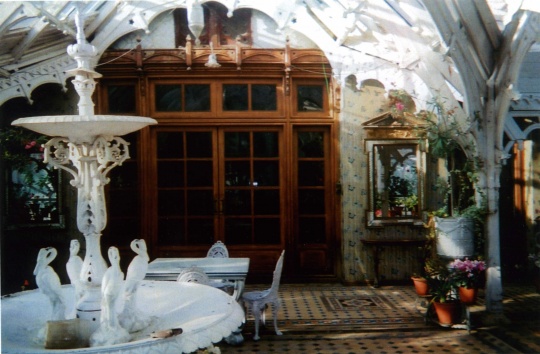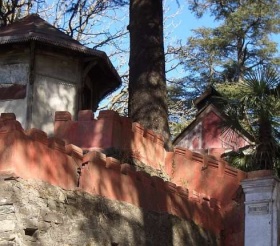Rothney Castle: Difference between revisions
No edit summary |
No edit summary |
||
| Line 1: | Line 1: | ||
[[Category:Places]] | [[Category:Places]] | ||
[[File:Rothney Castle by MG May 2006.jpg|540px|right|thumb|Rothney Castle interior, May 2006. Photo by Michael Gomes.]] | |||
[[File:Rothney Castle by MG May 2006.jpg| | |||
Rothney Castle was the home of [[A. O. Hume]], located on Jakko Hill in [[Simla, India]]. [[H. P. Blavatsky]], [[H. S. Olcott]], and [[A. P. Sinnett]] visited there frequently. | Rothney Castle was the home of [[A. O. Hume]], located on Jakko Hill in [[Simla, India]]. [[H. P. Blavatsky]], [[H. S. Olcott]], and [[A. P. Sinnett]] visited there frequently. | ||
[[File:Rothney Castle.jpg|280px|left|thumb|Rothney Castle]] | [[File:Rothney Castle.jpg|280px|left|thumb|Rothney Castle]] | ||
<br> | <br> | ||
| Line 22: | Line 11: | ||
<br> | <br> | ||
<br> | <br> | ||
<bahatma Letters to A. P. Sinnett'' (Adyar, Chennai, India: Theosophical Publishing House, 1972), 242.</ref> | |||
</blockquote> | |||
Mr. Hume was a Secretary to the Government of India when he purchased the property. His lavish expenditures in expanding the castle may have been intended to make it attractive for the government to purchase as a residence for the Viceroy: | |||
<blockquote> | |||
He added enormous reception rooms suitable for large dinner parties and balls, as well as a magnificent conservatory and spacious hall on the walls of which he displayed his superb collection of Indian horns. He engaged the services of an European gardener, and with his aid he made the grounds and conservatory a perpetual horticultural exhibition, to which he courteously admitted all visitors. | |||
<br> | <br> | ||
<br> | <br> | ||
But, possibly because ‘Rothney Castle’ can only be reached by a troublesome climb, any anticipations which Mr. Hume may have formed of the purchase of the building by Government were not realized, and Mr. Hume himself made little | |||
Revision as of 00:35, 4 September 2013

Rothney Castle was the home of A. O. Hume, located on Jakko Hill in Simla, India. H. P. Blavatsky, H. S. Olcott, and A. P. Sinnett visited there frequently.

<bahatma Letters to A. P. Sinnett (Adyar, Chennai, India: Theosophical Publishing House, 1972), 242.</ref>
Mr. Hume was a Secretary to the Government of India when he purchased the property. His lavish expenditures in expanding the castle may have been intended to make it attractive for the government to purchase as a residence for the Viceroy:
He added enormous reception rooms suitable for large dinner parties and balls, as well as a magnificent conservatory and spacious hall on the walls of which he displayed his superb collection of Indian horns. He engaged the services of an European gardener, and with his aid he made the grounds and conservatory a perpetual horticultural exhibition, to which he courteously admitted all visitors.
But, possibly because ‘Rothney Castle’ can only be reached by a troublesome climb, any anticipations which Mr. Hume may have formed of the purchase of the building by Government were not realized, and Mr. Hume himself made little